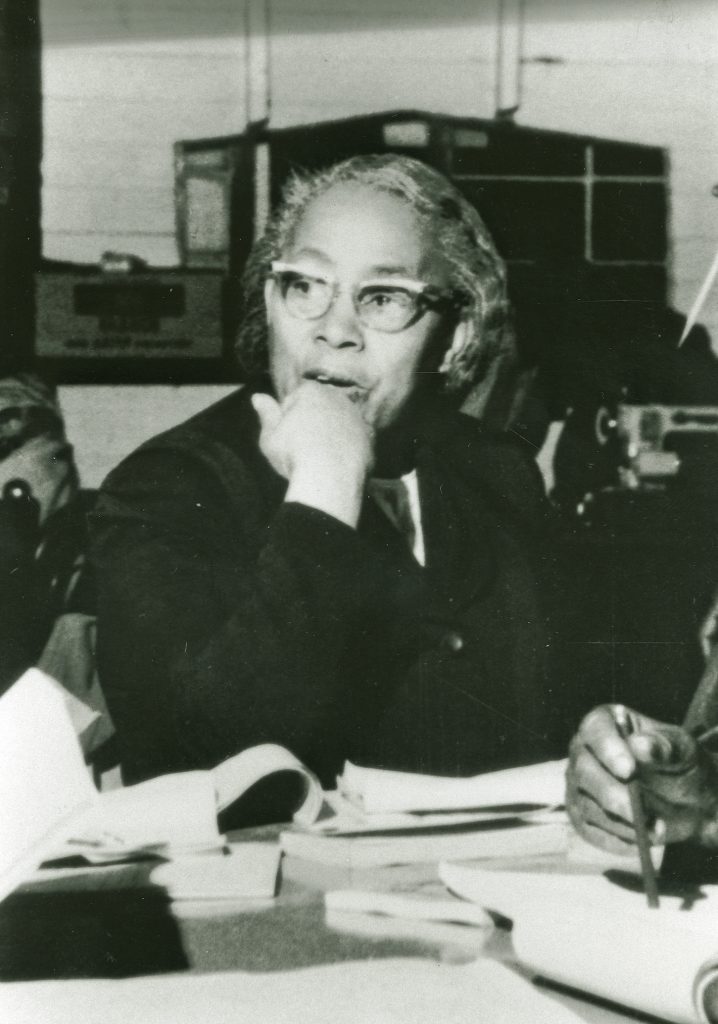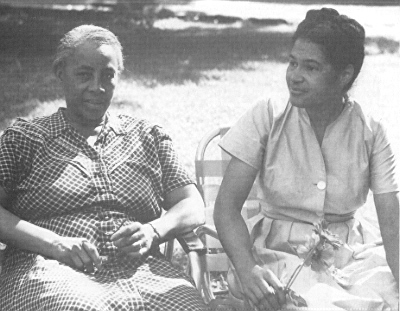Educator and civil rights activist Septima Poinsette Clark played a significant part in gaining voting and civil rights for African Americans. Clark is known as both the “queen mother” and “grandmother” of the Civil Rights movement and was commonly referred to by Martin Luther King, Jr. as “The mother of the Movement”.
On May 3, 1898, Septima Poinsette was born in Charleston, South Carolina to Peter and Victoria Warren Anderson Poinsette. Peter had been born into slavery and Victoria a laundress. Septima was the second of their eight children. Her mother wanted to raise her daughters into young ladies, so she kept her daughters separate from her sons, who had much more lenient rules. While the girls did chores and housework six days a week and only had one day for visiting the friends, the boys could any day they wanted to. Septima constantly rebelled against her mother though.
Both of her parents pushed her to get an education. At six years old in 1904, she began attending Mary Street School, but along with the other six-year olds at the school, she sat on the bleachers all day and learned nothing. When Victoria found out, she immediately took Septima out of the school. Instead, Poinsette was taught by an elderly woman in their neighborhood who was teaching girls to read and write. To pay for tuition, she would watch her teacher’s children every morning and evening. By 1914, a school for black sixth, seventh, and eighth graders opened in Charleston, though there was still no high school. When Poinsette finished sixth grade, she took a test and was able to advance to ninth grade at a high school called Avery founded by Missionaries from Massachusetts. In 1916, she finished high school but was unable to take college due to her family’s poor financial state. Poinsette took a state rast and began teaching school on John’s Island because blacks were not allowed to teach in Charleston when she was eighteen. She taught there from 1916-19 before returning to Avery to teach for a year. Later on, she would return to school part time in 1942 and earn her B.A.
Later on, she would recall being an african american teacher versus what it wa slike for white teachers. She was a teaching principal at a school with 132 students and only made $35 a week, while the teacher at the white school across the street had 3 students and made $85 a week.
During her time teaching on John’s Island, Poinsette first became familiar with the NAACP (National Association for the Advancement of Colored People). When she returned to Charleston, she joined the group’s Charleston Branch. The President of the NAACP in Charleston guided her to take her students around the city to ask for signatures on a petition to allow black principals at Avery. In only a day, she got 10,000 signatures, leading to black teachers being permitted, including becoming principals at public schools. This was Poinsette’s first of many political statement. She would work with the NAACP again in 1945 alongside Thurgood Marshall for black teachers to be given equal pay as white teachers in Columbia, South Carolina.
Poinsette met Nerie David Clark while she was teaching at Avery. For about three years, they dated until getting married in McClellanville in 1923 before moving to his hometown in North Carolina. However, Septima Clark’s relationship with her mother was ruined, because Victoria thought marrying a man from another state was like marrying a stranger. Septima was aware of the many cultural differences between her and her husband, as he had grown up a mountain man, and she a low-country girl. She often found herself homesick in Hickory, so they returned to Charleston. Clark began teaching again when they moved at Promise Land from 1926-29. She also had her first child around the same time, but the baby did not live, which she thought was a punishment for marrying a man from a different state. While Victoria refused to help her daughter out, Peter Poinsette was much kinder to her.
Afterwards, Clark moved to Columbia in 1929 and took up a teaching job there at Booker T. Washington High School. She was close with the principals and was a highly valued member of the school’s faculty. Clarke also went to complete her bachelor’s degree and studied at Benedict College. Clark also studied in New York at Columbia University and in Georgia at Atlanta University during the summers. Up until 1945, she was living in Columbia until she moved back to Charleston to care for her mother, who had just had a stroke. She still continued to teach and work with the NAACP though. She became the vice president of the Charleston branch of the NAACP in 1956.
However, that same year, legislations were passed in South Carolina to prevent city or state employees from being involved in the civil right’s movements and organizations. Clark, as a teacher, refused to leave the NAACP and was fired. Afterwards, no other school in Charleston would hire her and she was without a job.
Clark was also active in Tennessee with the Highlander Folk School, attending one of their workshops in 1954. The founder of the school soon hired her to be their full time director for workshops. Clarke soon began teaching literacy classes as well, which she had done decades before at John’s Island. Highlander was one of only a few integrated schools in the south and Clarke loved the community there. She was arrested in 1959 though for allegedly “possessing whiskey”. They ended up dropping the charges though because they were false.
Along with her cousin Bernice Robinson, she began expanding her program to teach students how to fill out driver’s license exams along with voter registration forms, mail-order form, and signing checks. At the same time, she even met Rosa Parks, who was participating in one of her workshops at Highlander. This was just shortly after Parks had become famous for refusing to leave her seat on a bus in Montgomery and starting a bus boycott in the city.
What Clarke is most well known for though is establishing “Citizenship Schools” where she taught adults in the Deep South how to read and write. The idea had developed over the course of her teaching literacy classes for the years prior. Her project both increased literacy rates, but also helped to empower black communities. Clark always made sure her students were interested in what they were learning and connected to both the politics and the needs of the people in her lessons. She taught mainly literacy, but taught citizenship rights as well. To avoid violence from whites, Clarke would teach her citizenship schools often times in the back of shops.
Her citizenship schools spread to many other states in the south as well. Myles Horton even recommended that she transfer the program to the Southern Christian Leadership Conference (SCLC) because it was growing so large. The founder of the organization, Martin Luther King, Jr., was at first hesitant about Clark’s idea, but ended up transferring the program to his organization in the end. However, the transfer did lead to financial problems for the Highlander Folk School. Nevertheless, with the help of the SCLC, Clark’s program had a much bigger budget and had around 10,000 teachers with more than 25,000 students. Clark was deeply dedicated to the voting rights movement and through her program, helped many other african americans to be able to vote. She soon became known around the country as she became the director of education and teaching for the SCLC as well and was the first woman to have a position on the organization’s board. One of the main struggles for her at the SCLC was the amount of sexism directed towards her. She would later express that the unfair treatment of women was “one of the greatest weaknesses of the civil rights movement.”
Throughout her career, Clark also worked with the Tuberculosis Association and with the health department in Charleston. In 1970, she retired from the SCLC but later on sought out reinstatement of her pension and would serve on the Charleston County School Board for two terms.
In 1979, President Jimmy Carter awarded her with a Living Legacy Award. Nearly a decade later in 1987, one of her autobiographies about the Civil Rights Movement won the American Book Award.
On December 15, 1987, Septima Poinsette Clarke died. She is buried in Charleston at Old Bethel United Methodist Church Cemetery.



